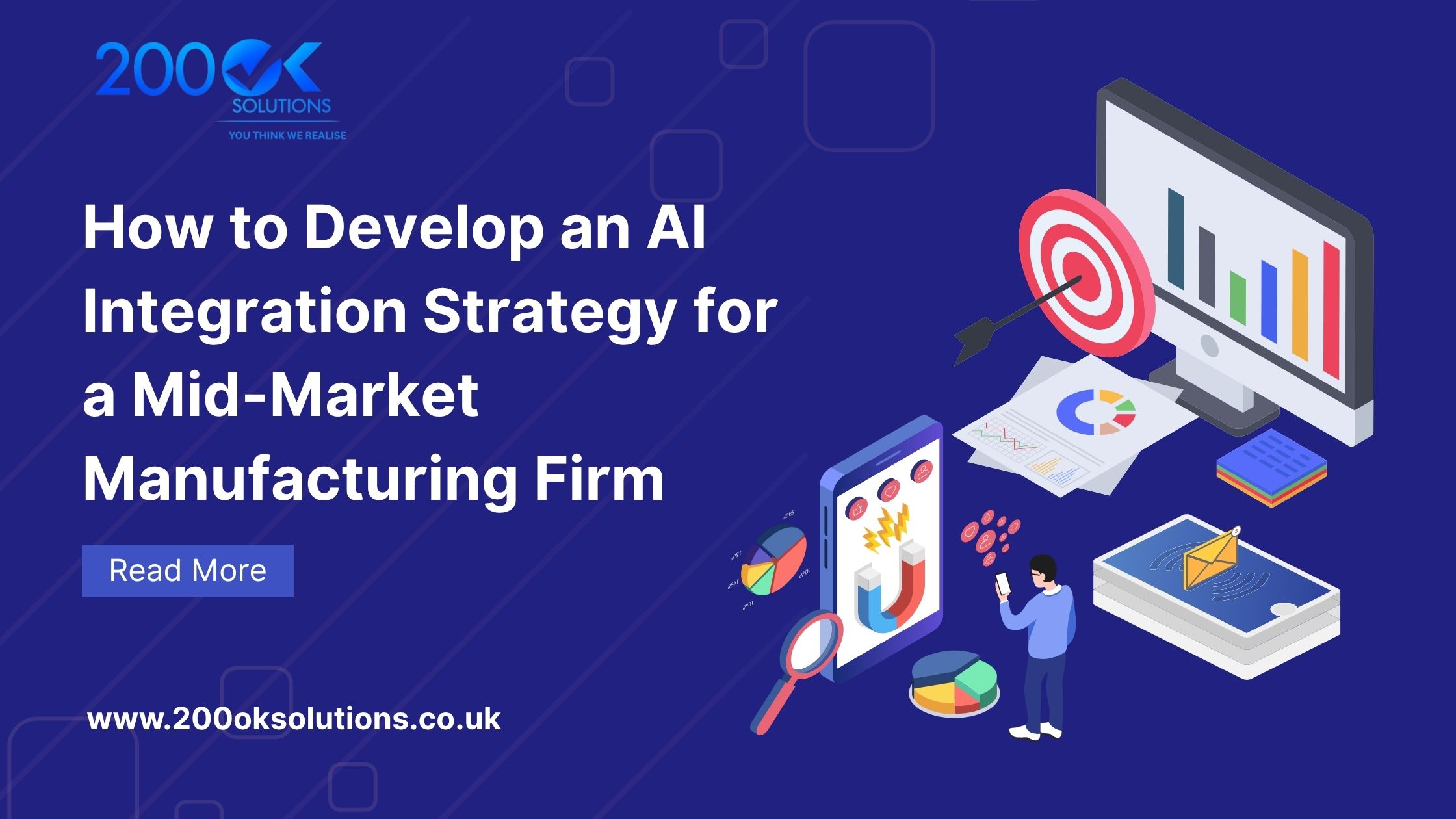The manufacturing landscape is undergoing a profound transformation. From Birmingham to Manchester, UK manufacturing facilities are embracing artificial intelligence to remain competitive in an increasingly digital world. For mid-market manufacturing firms, developing a robust AI integration strategy isn’t just about keeping pace with Industry 4.0 trends—it’s about survival and growth in a market where efficiency, quality, and agility determine success.
This comprehensive guide will walk you through the essential steps of building an AI strategy tailored specifically for mid-sized UK manufacturers, addressing the unique challenges and opportunities that define this critical sector.
Understanding the AI Manufacturing Landscape
AI manufacturing represents a fundamental shift in how production facilities operate. Unlike large enterprises with unlimited budgets, mid-market firms must approach AI adoption strategically, focusing on high-impact applications that deliver measurable returns. The smart factory concept, once reserved for industry giants, is now accessible to manufacturers of all sizes through cloud-based platforms, modular AI solutions, and increasingly affordable sensor technology.
Manufacturing AI encompasses various applications: predictive maintenance systems that prevent costly downtime, computer vision for quality control, AI supply chain optimization that reduces inventory costs, and intelligent production scheduling that maximizes throughput. For British manufacturers competing in global markets, these technologies aren’t optional—they’re essential tools for maintaining competitiveness.
The UK manufacturing sector faces unique pressures: Brexit-related supply chain complexities, skills shortages, rising energy costs, and increasing customization demands. An effective AI integration strategy addresses these challenges while building capabilities for future growth.
Assessing Your Current Manufacturing Maturity
Before diving into AI implementation, mid-market firms must honestly assess their digital maturity. This assessment forms the foundation of your AI roadmap for UK manufacturing SMEs and prevents costly missteps.
Start by evaluating your data infrastructure. AI thrives on quality data, yet many manufacturers still operate with disconnected systems, manual data entry, and incomplete records. Audit your current data sources: ERP systems, MES platforms, IoT sensors, and legacy equipment. Can these systems communicate? Is data standardized and accessible? Many mid-sized UK firms discover that their first step isn’t implementing AI but establishing proper data governance.
Examine your workforce capabilities. AI strategy development for UK factories requires people who understand both manufacturing processes and technology. Survey your team’s digital literacy. Do you have employees capable of interpreting AI insights and acting on recommendations? Building AI roadmap mid-sized UK firms succeed when they invest in training alongside technology.
Evaluate your physical infrastructure. Industry 4.0 requires connectivity. Assess your network capacity, edge computing capabilities, and sensor coverage across production lines. Mid-market plants often need infrastructure upgrades before deploying sophisticated AI applications.
Finally, review your financial position realistically. Cost-effective AI for UK mid-market plants exists, but implementation still requires investment. Understanding your budget constraints helps prioritize projects that deliver quick wins while building toward longer-term transformation.

Defining Clear Business Objectives
The most common mistake in AI adoption is implementing technology without clear business goals. Successful AI integration strategy for manufacturing UK operations begins with specific, measurable objectives tied directly to business performance.
Mid-market manufacturers should identify pain points where AI delivers immediate value. Is unplanned downtime costing thousands of pounds daily? Predictive maintenance might be your entry point. Struggling with quality consistency? Computer vision inspection could reduce defect rates. Carrying excessive inventory due to demand forecasting challenges? AI supply chain optimization could free up working capital.
Document baseline metrics before any AI implementation. If you’re targeting reduced downtime, know your current Overall Equipment Effectiveness (OEE) percentage. For quality improvements, establish current defect rates and rework costs. These baselines prove ROI and guide iterative improvements.
Consider both operational and strategic objectives. Operational goals might include reducing energy consumption by 15% or decreasing inventory holding costs by £200,000 annually. Strategic objectives could involve entering new markets requiring higher quality standards or building capabilities for mass customization.
For UK mid-market firms, sustainability increasingly drives AI strategy. Manufacturing AI can optimize energy usage, reduce material waste, and improve resource efficiency—critical factors as Britain pursues net-zero targets and customers demand greener supply chains.

Building Your AI Integration Roadmap
How to develop AI strategy mid-market firm successfully requires a phased approach that builds capabilities progressively while delivering value at each stage.
Phase One: Foundation Building (Months 1-6)
Begin with data infrastructure. Implement or upgrade your Manufacturing Execution System (MES) to capture real-time production data. Deploy IoT sensors on critical equipment. Establish data warehousing that consolidates information from disparate sources. This foundation enables all future AI applications.
Simultaneously, launch pilot projects with manageable scope and clear success metrics. Predictive maintenance AI strategy UK implementations often start with monitoring a single production line or critical asset. Choose equipment where failure is costly and data is readily available. Success in this pilot builds organizational confidence and demonstrates AI value to skeptical stakeholders.
Invest in workforce development. Partner with organizations like Made Smarter or local universities offering Manufacturing AI training. Develop internal champions who understand both shop floor realities and AI capabilities. These individuals bridge the gap between technology vendors and production teams.

Phase Two: Scaling Core Applications (Months 7-18)
With successful pilots validated, expand proven AI applications across additional production lines or facilities. This phase focuses on standardization and integration. Your predictive maintenance system that worked on one line should scale efficiently to similar equipment elsewhere.
Introduce additional AI use cases that build on existing infrastructure. If you’ve deployed sensor networks for predictive maintenance, leverage that same data for energy optimization or production optimization. This approach maximizes return on infrastructure investment.
Address integration challenges proactively. Manufacturing AI creates most value when systems communicate seamlessly. Your predictive maintenance alerts should trigger automatic work orders in your ERP system. Quality control findings should feed back to upstream process parameters. Step-by-step AI implementation manufacturing succeeds through thoughtful integration planning.

Phase Three: Advanced Optimization (Months 19-36)
With foundational AI capabilities established, mid-market firms can pursue sophisticated applications. Implement AI-driven production scheduling that dynamically optimizes for multiple variables: customer priorities, equipment availability, operator skills, and material constraints.
Deploy advanced AI supply chain capabilities. Move beyond demand forecasting to scenario planning, supplier risk assessment, and logistics optimization. British manufacturers particularly benefit from AI tools that navigate post-Brexit customs complexity and transportation challenges.
Explore emerging technologies like digital twins—virtual replicas of physical assets that enable risk-free experimentation with process changes. While computationally intensive, cloud platforms make digital twin technology increasingly accessible to mid-market operations.
Consider customer-facing AI applications. Configure-to-order systems powered by AI can expand your addressable market by enabling mass customization previously only feasible for high-volume products.
Overcoming AI Barriers Mid-Market Manufacturing Faces
Challenges AI adoption mid-sized factories UK encounter differ significantly from those facing large enterprises. Understanding and addressing these barriers determines strategy success.
Financial Constraints
Unlike automotive giants or aerospace manufacturers, mid-market firms can’t invest millions in AI infrastructure. Overcome this through:
- Cloud-based AI platforms that eliminate large upfront capital expenditure
- Government incentives like Made Smarter adoption programs offering grants and subsidized consulting
- Vendor partnerships where technology providers share implementation risk through performance-based pricing
- Focusing on use cases with sub-12-month payback periods to generate cash for subsequent investments
Skills Shortages
Finding staff who understand both manufacturing and AI is notoriously difficult. Address this through:
- Upskilling existing employees rather than only seeking external hires—your best AI talent may already work on your shop floor
- Apprenticeship programs combining traditional manufacturing skills with digital technologies
- Partnerships with universities offering Knowledge Transfer Partnerships (KTPs)
- Engaging specialist consultancies for initial implementations while transferring knowledge to internal teams
Technology Integration Complexity
Mid-market manufacturers often operate diverse equipment portfolios spanning decades. Legacy systems lack modern connectivity, creating integration nightmares. Solutions include:
- Retrofit sensor technologies that add connectivity to older equipment without replacing functional machinery
- Edge computing devices that translate between legacy protocols and modern systems
- Prioritizing standards-based technologies (OPC UA, MQTT) that facilitate future integration
- Accepting that complete integration isn’t necessary—even partial connectivity delivers significant value
Organizational Change Resistance
Shop floor skepticism toward AI is common, particularly in unionized environments or facilities with older workforces. Overcome resistance through:
- Transparent communication emphasizing how AI augments rather than replaces human expertise
- Involving operators in pilot project selection and design
- Celebrating quick wins and sharing success stories
- Demonstrating AI’s role in making work safer, less repetitive, and more interesting

Selecting the Right AI Tools for Manufacturing Strategy UK
The AI vendor landscape is crowded and confusing. Mid-market firms need selection criteria focused on practical implementation rather than flashy demonstrations.
Prioritize vendors with manufacturing-specific experience, particularly in UK markets where regulatory, labor, and operational contexts differ from other regions. Generic AI platforms require extensive customization; manufacturing-focused solutions offer pre-built models for common applications like predictive maintenance or quality control.
Evaluate vendors on integration capabilities. The best AI tools for manufacturing strategy UK implementations work with your existing systems—Sage, SAP Business One, Epicor, or whatever ERP you’ve already deployed. Avoid platforms requiring wholesale system replacement.
Consider deployment models carefully. Cloud solutions offer lower upfront costs and automatic updates but may raise data security concerns. On-premises or hybrid deployments provide greater control but require internal IT capabilities. Many mid-market firms find hybrid approaches optimal: cloud-based training and model development with edge deployment for real-time manufacturing applications.
Assess vendor viability and support structures. AI startups offer cutting-edge capabilities but may lack long-term stability. Established industrial automation vendors (Siemens, Rockwell, Schneider Electric) provide reliability but potentially less innovation. Regional specialists often deliver the best balance for UK mid-market manufacturers: manufacturing expertise, local support, and appropriate scale.
Demand proof of concept opportunities. Legitimate vendors confident in their technology will pilot applications in your facility before requiring major commitments. These trials reveal integration challenges, validate ROI assumptions, and demonstrate practical value.

Implementing Predictive Maintenance: A Practical Entry Point
Predictive maintenance represents the most accessible and high-impact starting point for most AI integration strategy for manufacturing UK projects. The application delivers clear ROI while building capabilities for more advanced AI adoption.
Traditional preventive maintenance follows fixed schedules, replacing components based on manufacturer recommendations or historical averages. This approach either services equipment too frequently (wasting resources) or too infrequently (risking failures). Predictive maintenance AI strategy UK implementations use real-time equipment data to predict failures before they occur, optimizing maintenance timing.
Begin by identifying critical assets where unplanned downtime is costliest. CNC machines, injection molding equipment, industrial robots, and packaging lines are common candidates. Install vibration sensors, thermal cameras, and current monitors on these assets. Modern IIoT sensors are increasingly affordable, with complete monitoring kits available for under £500 per machine.
Collect baseline data during normal operations for 30-60 days. This period establishes equipment “fingerprints”—normal operating patterns against which anomalies are detected. Cloud platforms from vendors like Azure IoT or AWS IoT process this data, building machine learning models that identify developing issues.
The AI system learns to distinguish between normal variations and genuine problems. Bearing wear creates specific vibration signatures. Motor failures show characteristic changes in current draw. Overheating precedes many mechanical failures. The system alerts maintenance teams to these patterns, typically providing 1-4 weeks advance warning.
For mid-sized UK firms, predictive maintenance typically reduces unplanned downtime by 30-50% while cutting maintenance costs 20-25%. A manufacturer with £50,000 monthly downtime costs can justify significant AI investment based solely on these savings.
Success requires integrating predictive alerts with maintenance workflows. Alerts should automatically generate work orders in your CMMS (Computerized Maintenance Management System), schedule technicians, and order necessary parts. Without this integration, alerts become another information stream that overwhelms rather than empowers maintenance teams.

Optimizing Supply Chains with AI
AI supply chain optimization addresses particularly acute challenges for British manufacturers navigating post-Brexit complexity, global disruptions, and increasing customer expectations for shorter lead times.
Start with demand forecasting—the foundation of supply chain efficiency. Traditional forecasting uses historical sales data and simple trend analysis. Manufacturing AI incorporates additional variables: economic indicators, weather patterns, social media sentiment, competitor actions, and market trends. Machine learning algorithms identify complex patterns invisible to human analysts, improving forecast accuracy 20-40%.
Better forecasts cascade through supply chains. Procurement orders more accurately, reducing both stockouts and excess inventory. Production scheduling optimizes for actual demand rather than inflated safety buffers. Customer service improves as delivery promises become more reliable.
Inventory optimization represents the next AI application. Rather than fixed reorder points, AI dynamically adjusts inventory levels based on demand variability, supplier reliability, and lead time uncertainty. For UK mid-market manufacturers carrying £2-5 million in inventory, even modest improvements free substantial working capital.
Supplier risk management grows increasingly critical. AI monitors multiple risk signals: financial health indicators, logistics disruptions, geopolitical developments, and quality trends. The system alerts procurement when supplier risk increases, enabling proactive mitigation before disruptions impact production.
Logistics optimization uses AI to route shipments optimally, consolidate orders, and select carriers based on cost, speed, and reliability. For manufacturers with complex distribution networks, these algorithms reduce transportation costs 10-15% while improving delivery performance.
Implementing AI supply chain solutions requires clean master data—accurate BOMs (Bills of Materials), validated supplier information, and reliable lead times. Many mid-market firms discover data cleanup is their largest implementation challenge. However, this effort delivers value beyond AI, improving fundamental supply chain execution.
Measuring Success and ROI
Benefits AI integration manufacturing SMEs deliver must be measured rigorously. Unlike large corporations that can absorb experimental technology costs, mid-market firms need demonstrable returns.
Establish clear KPIs before implementation. Common metrics include:
- OEE (Overall Equipment Effectiveness): Industry 4.0 initiatives typically improve OEE 5-15 percentage points
- First Pass Yield: AI quality control often increases yield 2-5%
- Inventory Turns: Supply chain AI commonly improves turns by 15-30%
- Energy Consumption: Smart factory systems reduce energy usage 8-15%
- On-Time Delivery: Production optimization improves delivery performance 10-20%
- Defect Rates: Computer vision inspection reduces customer complaints 30-60%
Calculate fully loaded costs including software licenses, hardware, implementation services, training, and internal resource time. Compare against quantified benefits: downtime reduction, labor savings, quality improvements, and inventory reductions. Conservative ROI calculations assume implementations take longer and deliver less than vendor promises—mid-market firms should target minimum 30% ROI to justify AI investments.
Track both hard and soft benefits. Hard benefits like reduced scrap or lower maintenance costs directly impact P&L. Soft benefits include improved decision-making speed, better customer satisfaction, and enhanced employee engagement. While harder to quantify, these contribute significantly to competitive advantage.
Implement continuous improvement processes. AI systems improve as they process more data and users refine models based on operational experience. Schedule quarterly reviews assessing performance against targets and identifying optimization opportunities.

Building Sustainable AI Integration Manufacturing UK
Sustainable AI integration manufacturing UK strategies extend beyond environmental considerations to encompass long-term organizational capability building.
Avoid vendor lock-in through open standards and modular architectures. Your AI strategy should enable changing vendors, adding capabilities, and integrating emerging technologies without wholesale replacement of existing investments. Data portability is particularly critical—ensure you maintain ownership and access to all data generated by AI systems.
Develop internal AI literacy across the organization. Manufacturing AI creates most value when shop floor workers, engineers, managers, and executives all understand capabilities and limitations. Regular training, internal success story sharing, and cross-functional AI teams build organizational competency.
Plan for scaling from the start. Pilot projects should use technologies and architectures that extend across multiple sites, product lines, or applications. The predictive maintenance system deployed in Manchester should scale efficiently to your Birmingham facility with minimal customization.
Address cybersecurity proactively. Connected manufacturing environments create attack surfaces. Implement network segmentation, regular security audits, and incident response plans. Many mid-market firms lack dedicated IT security expertise; partnering with managed security service providers specifically experienced in manufacturing environments mitigates this gap.
Consider environmental impacts as competitive advantage. AI that reduces energy consumption, optimizes material usage, and minimizes waste helps meet regulatory requirements while reducing costs. As customers increasingly demand sustainable supply chains, demonstrating environmental leadership through smart factory technologies differentiates your firm.
Conclusion: Taking the First Steps
Developing an AI strategy for mid-market manufacturers means balancing innovation with practicality. While the vision of fully autonomous smart factories is still emerging, achievable AI adoption can deliver measurable results today.
Start by securing leadership commitment and investing for the long term—AI transformation typically spans 2–3 years. Appoint internal champions who bridge manufacturing know-how with digital innovation to sustain momentum.
Begin with focused, high-impact projects such as predictive maintenance or demand forecasting, which offer strong returns and organizational buy-in. Leverage resources from initiatives like Made Smarter, Innovate UK, and Catapult centres for guidance and support.
Remember, AI integration is a gradual journey built on clear vision, phased execution, and continuous improvement. Manufacturers adopting AI effectively gain advantages in cost efficiency, quality, delivery reliability, and innovation speed.
For mid-market firms, the key question isn’t whether to adopt AI—but how soon to start the transformation journey.


